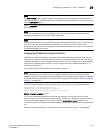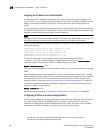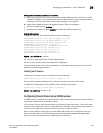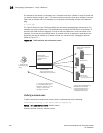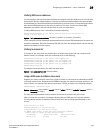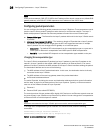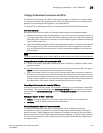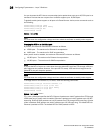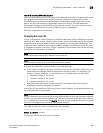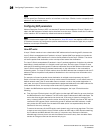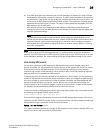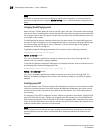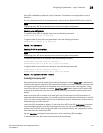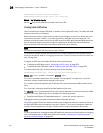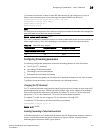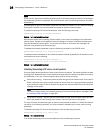
PowerConnect B-Series FCX Configuration Guide 809
53-1002266-01
Configuring IP parameters – Layer 3 Switches
26
Path MTU discovery (RFC 1191) support
When the Dell PowerConnect device receives an IP packet that has its Do not Fragment (DF) bit set,
and the packet size is greater than the MTU value of the outbound interface, then the Dell
PowerConnect device returns an ICMP Destination Unreachable message to the source of the
packet, with the Code indicating "fragmentation needed and DF set". The ICMP Destination
Unreachable message includes the MTU of the outbound interface. The source host can use this
information to help determine the maximum MTU of a path to a destination.
RFC 1191 is supported on all interfaces.
Changing the router ID
In most configurations, a Layer 3 Switch has multiple IP addresses, usually configured on different
interfaces. As a result, a Layer 3 Switch identity to other devices varies depending on the interface
to which the other device is attached. Some routing protocols, including Open Shortest Path First
(OSPF) and Border Gateway Protocol version 4 (BGP4), identify a Layer 3 Switch by just one of the
IP addresses configured on the Layer 3 Switch, regardless of the interfaces that connect the Layer
3 Switches. This IP address is the router ID.
NOTE
Routing Information Protocol (RIP) does not use the router ID.
NOTE
If you change the router ID, all current BGP4 sessions are cleared.
By default, the router ID on a Layer 3 Switch is one of the following:
• If the router has loopback interfaces, the default router ID is the IP address configured on the
lowest numbered loopback interface configured on the Layer 3 Switch. For example, if you
configure loopback interfaces 1, 2, and 3 as follows, the default router ID is 9.9.9.9/24:
- Loopback interface 1, 9.9.9.9/24
- Loopback interface 2, 4.4.4.4/24
- Loopback interface 3, 1.1.1.1/24
• If the device does not have any loopback interfaces, the default router ID is the lowest
numbered IP interface configured on the device.
If you prefer, you can explicitly set the router ID to any valid IP address. The IP address cannot be in
use on another device in the network.
NOTE
Layer 3 Switches use the same router ID for both OSPF and BGP4. If the router is already configured
for OSPF, you may want to use the router ID that is already in use on the router rather than set a new
one. To display the router ID, enter the show ip command at any CLI level or select the IP->General
links from the Configure tree in the Web Management Interface.
To change the router ID, enter a command such as the following.
PowerConnect(config)# ip router-id 209.157.22.26
Syntax: ip router-id <ip-addr>
The <ip-addr> can be any valid, unique IP address.



